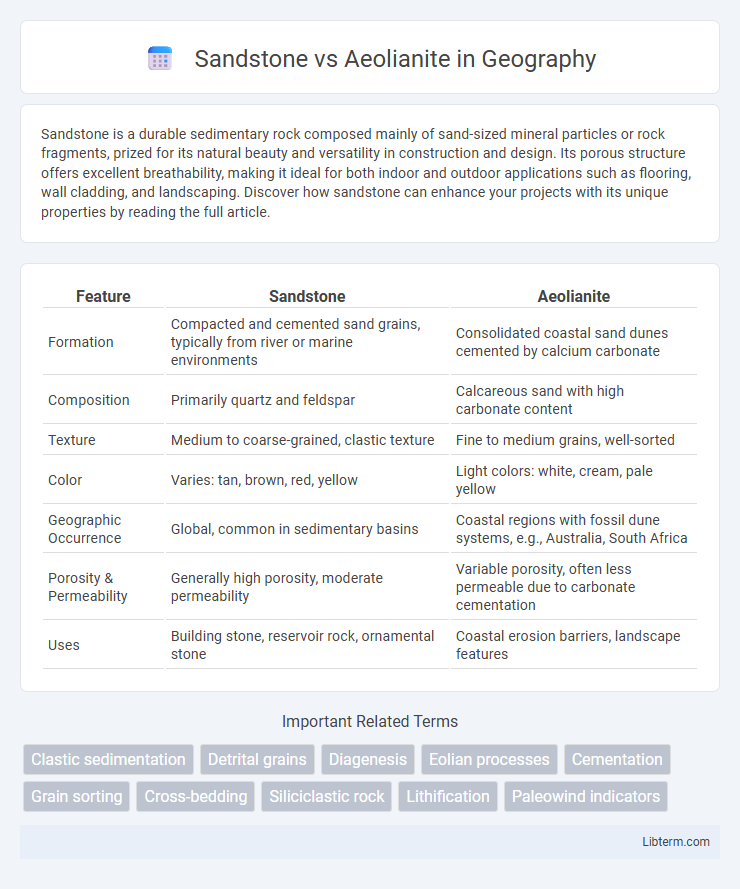Sandstone is a durable sedimentary rock composed mainly of sand-sized mineral particles or rock fragments, prized for its natural beauty and versatility in construction and design. Its porous structure offers excellent breathability, making it ideal for both indoor and outdoor applications such as flooring, wall cladding, and landscaping. Discover how sandstone can enhance your projects with its unique properties by reading the full article.
Table of Comparison
| Feature | Sandstone | Aeolianite |
|---|---|---|
| Formation | Compacted and cemented sand grains, typically from river or marine environments | Consolidated coastal sand dunes cemented by calcium carbonate |
| Composition | Primarily quartz and feldspar | Calcareous sand with high carbonate content |
| Texture | Medium to coarse-grained, clastic texture | Fine to medium grains, well-sorted |
| Color | Varies: tan, brown, red, yellow | Light colors: white, cream, pale yellow |
| Geographic Occurrence | Global, common in sedimentary basins | Coastal regions with fossil dune systems, e.g., Australia, South Africa |
| Porosity & Permeability | Generally high porosity, moderate permeability | Variable porosity, often less permeable due to carbonate cementation |
| Uses | Building stone, reservoir rock, ornamental stone | Coastal erosion barriers, landscape features |
Introduction to Sandstone and Aeolianite
Sandstone is a sedimentary rock composed mainly of sand-sized mineral particles or rock fragments, typically quartz or feldspar, cemented together by silica, calcium carbonate, or iron oxides. Aeolianite is a type of sandstone formed by the lithification of wind-blown sand dunes, characterized by its distinct cross-bedding and high porosity. Both rocks demonstrate sedimentary processes, but aeolianite uniquely records ancient desert or coastal dune environments shaped by wind activity.
Geological Formation Processes
Sandstone forms primarily through the compaction and cementation of sand-sized mineral grains, often quartz, deposited by water or wind in environments like rivers, beaches, and deserts. Aeolianite is a type of sandstone specifically formed from wind-blown sand dunes that have been lithified through calcite or silica cementation, predominantly in coastal or arid regions with significant aeolian activity. Both formations illustrate sedimentary processes, but aeolianite's origin emphasizes wind-driven sediment transport and dune stabilization before lithification.
Mineral Composition and Characteristics
Sandstone primarily consists of quartz, feldspar, and clay minerals, exhibiting a granular texture with varying hardness and porosity levels. Aeolianite, formed from cemented wind-blown sands, predominantly contains well-sorted quartz grains bound by calcium carbonate cement, resulting in a smoother texture and higher durability. The mineral composition directly influences permeability and erosion resistance, distinguishing sandstone's varied characteristics from the more uniform and compact nature of aeolianite.
Appearance and Texture Differences
Sandstone typically exhibits a coarse to medium grain texture with visible quartz and feldspar grains, often resulting in a rough and gritty surface. Aeolianite, formed from wind-deposited sands, features a finer, well-sorted texture with smooth, rounded grains and displays a more uniform, often pale coloration compared to the varied hues of sandstone. The surface of aeolianite tends to be more compact and less porous, giving it a polished appearance in contrast to the more rugged look of sandstone.
Geographic Distribution and Locations
Sandstone is globally distributed with significant formations found in the Colorado Plateau in the United States, the Sahara Desert in Africa, and the Sydney Basin in Australia. Aeolianite is primarily located along coastal regions where wind-blown sand accumulates and lithifies, including areas like the coasts of Western Australia, South Africa, and the Mediterranean Basin. The geographic distinction lies in sandstone's widespread sedimentary environments compared to aeolianite's specific formation in ancient coastal dune systems.
Environmental Conditions of Formation
Sandstone forms primarily in various environments such as rivers, deltas, and beaches where sediment is deposited by water or wind under relatively stable conditions. Aeolianite specifically develops in coastal dune systems through the lithification of wind-blown sand in arid or semi-arid climates with fluctuating moisture and temperature. The key environmental difference lies in sandstone's broader depositional settings versus aeolianite's origin in terrestrial, wind-dominated, and often saline coastal environments.
Durability and Weathering Properties
Sandstone, composed mainly of quartz grains bound by silica or calcite cement, exhibits high durability due to its hardness and resistance to abrasion, making it suitable for various construction applications. Aeolianite, a type of consolidated dune sand primarily cemented by calcium carbonate, is less durable and more susceptible to chemical weathering and erosion in humid or acidic environments. The porosity of Aeolianite contributes to increased weathering rates compared to sandstone, which generally demonstrates better long-term stability under diverse climatic conditions.
Uses in Construction and Architecture
Sandstone and aeolianite are both popular building materials, but their uses in construction and architecture differ due to their distinct properties. Sandstone is widely used for load-bearing walls, facades, and ornamental detailing because of its durability and natural variety of colors, making it suitable for both structural and decorative applications. Aeolianite, a wind-formed limestone, is lighter and easier to carve, often utilized in coastal architecture for cladding, paving, and ornamental features where weather resistance and aesthetic appeal are prioritized.
Importance in Paleoenvironments
Sandstone and aeolianite both serve as crucial indicators in reconstructing paleoenvironments due to their distinct depositional origins. Sandstone typically forms in fluvial, deltaic, or marine settings, reflecting ancient sedimentary processes and climate conditions, while aeolianite, formed from wind-blown sand deposits, signals past arid, coastal, or desert environments. Understanding the textural and compositional differences between sandstone and aeolianite enhances paleoclimatic interpretations and aids in identifying historic wind patterns, sea-level changes, and sedimentary basin evolution.
Conclusion: Choosing Between Sandstone and Aeolianite
Selecting between sandstone and aeolianite depends on project requirements such as durability, porosity, and aesthetic preference. Sandstone offers high strength and weather resistance, ideal for structural applications, while aeolianite's unique fossil content and lighter texture suit decorative and coastal environments. Understanding the geological properties and environmental context ensures the optimal choice for long-lasting construction or design outcomes.
Sandstone Infographic

 libterm.com
libterm.com